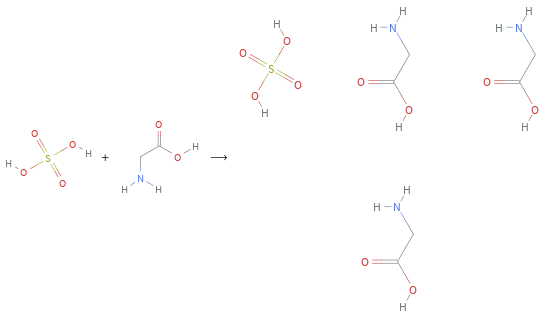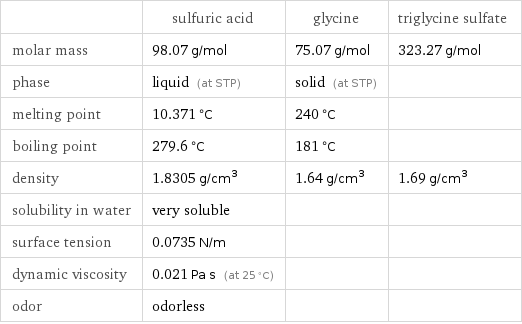Input interpretation

H_2SO_4 sulfuric acid + NH_2CH_2COOH glycine ⟶ C_6H_17N_3O_10S triglycine sulfate
Balanced equation

Balance the chemical equation algebraically: H_2SO_4 + NH_2CH_2COOH ⟶ C_6H_17N_3O_10S Add stoichiometric coefficients, c_i, to the reactants and products: c_1 H_2SO_4 + c_2 NH_2CH_2COOH ⟶ c_3 C_6H_17N_3O_10S Set the number of atoms in the reactants equal to the number of atoms in the products for H, O, S, C and N: H: | 2 c_1 + 5 c_2 = 17 c_3 O: | 4 c_1 + 2 c_2 = 10 c_3 S: | c_1 = c_3 C: | 2 c_2 = 6 c_3 N: | c_2 = 3 c_3 Since the coefficients are relative quantities and underdetermined, choose a coefficient to set arbitrarily. To keep the coefficients small, the arbitrary value is ordinarily one. For instance, set c_1 = 1 and solve the system of equations for the remaining coefficients: c_1 = 1 c_2 = 3 c_3 = 1 Substitute the coefficients into the chemical reaction to obtain the balanced equation: Answer: | | H_2SO_4 + 3 NH_2CH_2COOH ⟶ C_6H_17N_3O_10S
Structures

+ ⟶
Names

sulfuric acid + glycine ⟶ triglycine sulfate
Equilibrium constant
![Construct the equilibrium constant, K, expression for: H_2SO_4 + NH_2CH_2COOH ⟶ C_6H_17N_3O_10S Plan: • Balance the chemical equation. • Determine the stoichiometric numbers. • Assemble the activity expression for each chemical species. • Use the activity expressions to build the equilibrium constant expression. Write the balanced chemical equation: H_2SO_4 + 3 NH_2CH_2COOH ⟶ C_6H_17N_3O_10S Assign stoichiometric numbers, ν_i, using the stoichiometric coefficients, c_i, from the balanced chemical equation in the following manner: ν_i = -c_i for reactants and ν_i = c_i for products: chemical species | c_i | ν_i H_2SO_4 | 1 | -1 NH_2CH_2COOH | 3 | -3 C_6H_17N_3O_10S | 1 | 1 Assemble the activity expressions accounting for the state of matter and ν_i: chemical species | c_i | ν_i | activity expression H_2SO_4 | 1 | -1 | ([H2SO4])^(-1) NH_2CH_2COOH | 3 | -3 | ([NH2CH2COOH])^(-3) C_6H_17N_3O_10S | 1 | 1 | [C6H17N3O10S] The equilibrium constant symbol in the concentration basis is: K_c Mulitply the activity expressions to arrive at the K_c expression: Answer: | | K_c = ([H2SO4])^(-1) ([NH2CH2COOH])^(-3) [C6H17N3O10S] = ([C6H17N3O10S])/([H2SO4] ([NH2CH2COOH])^3)](../image_source/68806a3a04885b16d03d07b2a73d6d6a.png)
Construct the equilibrium constant, K, expression for: H_2SO_4 + NH_2CH_2COOH ⟶ C_6H_17N_3O_10S Plan: • Balance the chemical equation. • Determine the stoichiometric numbers. • Assemble the activity expression for each chemical species. • Use the activity expressions to build the equilibrium constant expression. Write the balanced chemical equation: H_2SO_4 + 3 NH_2CH_2COOH ⟶ C_6H_17N_3O_10S Assign stoichiometric numbers, ν_i, using the stoichiometric coefficients, c_i, from the balanced chemical equation in the following manner: ν_i = -c_i for reactants and ν_i = c_i for products: chemical species | c_i | ν_i H_2SO_4 | 1 | -1 NH_2CH_2COOH | 3 | -3 C_6H_17N_3O_10S | 1 | 1 Assemble the activity expressions accounting for the state of matter and ν_i: chemical species | c_i | ν_i | activity expression H_2SO_4 | 1 | -1 | ([H2SO4])^(-1) NH_2CH_2COOH | 3 | -3 | ([NH2CH2COOH])^(-3) C_6H_17N_3O_10S | 1 | 1 | [C6H17N3O10S] The equilibrium constant symbol in the concentration basis is: K_c Mulitply the activity expressions to arrive at the K_c expression: Answer: | | K_c = ([H2SO4])^(-1) ([NH2CH2COOH])^(-3) [C6H17N3O10S] = ([C6H17N3O10S])/([H2SO4] ([NH2CH2COOH])^3)
Rate of reaction
![Construct the rate of reaction expression for: H_2SO_4 + NH_2CH_2COOH ⟶ C_6H_17N_3O_10S Plan: • Balance the chemical equation. • Determine the stoichiometric numbers. • Assemble the rate term for each chemical species. • Write the rate of reaction expression. Write the balanced chemical equation: H_2SO_4 + 3 NH_2CH_2COOH ⟶ C_6H_17N_3O_10S Assign stoichiometric numbers, ν_i, using the stoichiometric coefficients, c_i, from the balanced chemical equation in the following manner: ν_i = -c_i for reactants and ν_i = c_i for products: chemical species | c_i | ν_i H_2SO_4 | 1 | -1 NH_2CH_2COOH | 3 | -3 C_6H_17N_3O_10S | 1 | 1 The rate term for each chemical species, B_i, is 1/ν_i(Δ[B_i])/(Δt) where [B_i] is the amount concentration and t is time: chemical species | c_i | ν_i | rate term H_2SO_4 | 1 | -1 | -(Δ[H2SO4])/(Δt) NH_2CH_2COOH | 3 | -3 | -1/3 (Δ[NH2CH2COOH])/(Δt) C_6H_17N_3O_10S | 1 | 1 | (Δ[C6H17N3O10S])/(Δt) (for infinitesimal rate of change, replace Δ with d) Set the rate terms equal to each other to arrive at the rate expression: Answer: | | rate = -(Δ[H2SO4])/(Δt) = -1/3 (Δ[NH2CH2COOH])/(Δt) = (Δ[C6H17N3O10S])/(Δt) (assuming constant volume and no accumulation of intermediates or side products)](../image_source/b081e7234a143bd4f892bbe5e4a285f7.png)
Construct the rate of reaction expression for: H_2SO_4 + NH_2CH_2COOH ⟶ C_6H_17N_3O_10S Plan: • Balance the chemical equation. • Determine the stoichiometric numbers. • Assemble the rate term for each chemical species. • Write the rate of reaction expression. Write the balanced chemical equation: H_2SO_4 + 3 NH_2CH_2COOH ⟶ C_6H_17N_3O_10S Assign stoichiometric numbers, ν_i, using the stoichiometric coefficients, c_i, from the balanced chemical equation in the following manner: ν_i = -c_i for reactants and ν_i = c_i for products: chemical species | c_i | ν_i H_2SO_4 | 1 | -1 NH_2CH_2COOH | 3 | -3 C_6H_17N_3O_10S | 1 | 1 The rate term for each chemical species, B_i, is 1/ν_i(Δ[B_i])/(Δt) where [B_i] is the amount concentration and t is time: chemical species | c_i | ν_i | rate term H_2SO_4 | 1 | -1 | -(Δ[H2SO4])/(Δt) NH_2CH_2COOH | 3 | -3 | -1/3 (Δ[NH2CH2COOH])/(Δt) C_6H_17N_3O_10S | 1 | 1 | (Δ[C6H17N3O10S])/(Δt) (for infinitesimal rate of change, replace Δ with d) Set the rate terms equal to each other to arrive at the rate expression: Answer: | | rate = -(Δ[H2SO4])/(Δt) = -1/3 (Δ[NH2CH2COOH])/(Δt) = (Δ[C6H17N3O10S])/(Δt) (assuming constant volume and no accumulation of intermediates or side products)
Chemical names and formulas

| sulfuric acid | glycine | triglycine sulfate formula | H_2SO_4 | NH_2CH_2COOH | C_6H_17N_3O_10S Hill formula | H_2O_4S | C_2H_5NO_2 | C_6H_17N_3O_10S name | sulfuric acid | glycine | triglycine sulfate IUPAC name | sulfuric acid | 2-aminoacetic acid | 2-aminoacetic acid; sulfuric acid
Substance properties

| sulfuric acid | glycine | triglycine sulfate molar mass | 98.07 g/mol | 75.07 g/mol | 323.27 g/mol phase | liquid (at STP) | solid (at STP) | melting point | 10.371 °C | 240 °C | boiling point | 279.6 °C | 181 °C | density | 1.8305 g/cm^3 | 1.64 g/cm^3 | 1.69 g/cm^3 solubility in water | very soluble | | surface tension | 0.0735 N/m | | dynamic viscosity | 0.021 Pa s (at 25 °C) | | odor | odorless | |
Units
